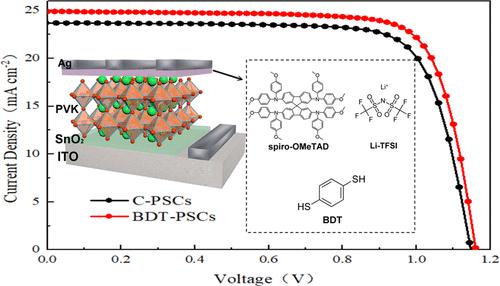含1,4-苯二硫醇添加剂的Spiro-OMeTAD促进高性能钙钛矿太阳能电池
IF 4.6
2区 化学
Q2 CHEMISTRY, PHYSICAL
引用次数: 0
摘要
小分子材料螺-OMeTAD 被广泛用作高效 ni-i-p 包晶太阳能电池(PSCs)的空穴传输层(HTL)。然而,螺-OMeTAD 固有的低导电性和空穴迁移率,加上其强烈的吸湿性,严重限制了器件的性能和使用寿命。在此,我们采用一种低成本的 1,4-苯二硫醇(BDT)添加剂来克服原始螺-OMeTAD 的限制。在螺-OMeTAD 中掺入 BDT 可以提高载流子迁移率和导电性。同时,由于 BDT 中含有巯基,降低了螺-OMeTAD 的吸湿性。此外,掺杂 BDT 器件的陷阱态密度和缺陷诱导的非辐射重组也有所降低。此外,HTL 和过氧化物层之间能级排列的改善也有助于提高空穴传输效率。因此,掺杂了 BDT 的刚性 PSC 和柔性 PSC 的功率转换效率(PCE)分别达到了 22.34% 和 21.04%,超过了原始刚性 PSC 和柔性 PSC 分别达到的 20.83% 和 19.64% 的功率转换效率。此外,基于 BDT 的设备比对照设备表现出更好的稳定性。本文章由计算机程序翻译,如有差异,请以英文原文为准。

Spiro-OMeTAD with a 1,4-Benzenedithiol Additive to Promote High-Performance Perovskite Solar Cells
Small molecule material spiro-OMeTAD is widely employed as the hole transport layer (HTL) in efficient n-i-p perovskite solar cells (PSCs). However, the intrinsic poor conductivity and hole mobility of spiro-OMeTAD, coupled with its strong hygroscopic nature, severely limit the performance and lifetime of the devices. Herein, we employ a low-cost 1,4-benzenedithiol (BDT) additive to overcome the limits of pristine spiro-OMeTAD. BDT doping in spiro-OMeTAD can increase the carrier mobility and electrical conductivity. Meanwhile, because of the sulfhydryl group in BDT, the hygroscopic nature of spiro-OMeTAD is decreased. Furthermore, the trap-state density and defect-induced nonradiative recombination of the BDT-doped device are decreased. Additionally, the improved energy level alignment between the HTL and the perovskite layer facilitates more efficient hole transport. Consequently, the rigid PSC and flexible PSC doped with BDT achieve champion power conversion efficiencies (PCEs) of 22.34% and 21.04%, respectively, surpassing the PCEs of 20.83% and 19.64% obtained from the original rigid PSC and flexible PSC, respectively. Furthermore, the BDT-based devices exhibit better stability than control devices.
求助全文
通过发布文献求助,成功后即可免费获取论文全文。
去求助
来源期刊

The Journal of Physical Chemistry Letters
CHEMISTRY, PHYSICAL-NANOSCIENCE & NANOTECHNOLOGY
CiteScore
9.60
自引率
7.00%
发文量
1519
审稿时长
1.6 months
期刊介绍:
The Journal of Physical Chemistry (JPC) Letters is devoted to reporting new and original experimental and theoretical basic research of interest to physical chemists, biophysical chemists, chemical physicists, physicists, material scientists, and engineers. An important criterion for acceptance is that the paper reports a significant scientific advance and/or physical insight such that rapid publication is essential. Two issues of JPC Letters are published each month.
 求助内容:
求助内容: 应助结果提醒方式:
应助结果提醒方式:


